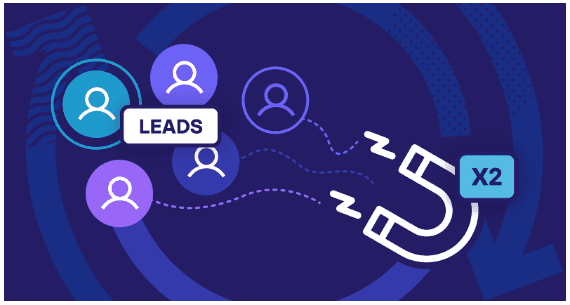Table of Contents
ToggleAchieving CAC payback is critical for any SaaS business looking to grow sustainably. Customer Acquisition Cost (CAC) is the total cost of sales and marketing activities divided by the number of new customers acquired. CAC payback is the time it takes to recoup the cost of acquiring a new customer. Achieving CAC payback is critical for any SaaS business looking to grow sustainably.
To achieve CAC payback, SaaS companies must focus on effective marketing strategies to help them acquire customers at a lower cost. This requires profoundly understanding the target audience, their pain points, and how your product or service can solve their problems.
You can attract potential customers and generate leads by creating relevant content, running targeted ad campaigns, and leveraging social media.
Another effective strategy to achieve CAC payback is to optimize your pricing model. By offering tiered pricing plans that cater to the different needs of your customers, you can increase customer acquisition while minimizing acquisition costs.
Additionally, leveraging referral programs and partnerships with complementary businesses can help you acquire customers at a lower cost.
By implementing these strategies, SaaS companies can achieve CAC payback and set themselves up for sustainable growth in the long run.
What is CAC Payback?
CAC Payback is a metric SaaS businesses use to determine the time it takes to recoup the cost of acquiring a new customer. CAC Payback helps companies understand the profitability of their marketing and sales efforts by measuring the amount of time it takes for the revenue generated by a new customer to exceed the cost of acquiring that customer.
The formula for CAC Payback is simple – the total cost of sales and marketing activities divided by the number of new customers acquired in a given period.
For example, if a company spends $10,000 on sales and marketing activities in a month and acquires 100 new customers in that same month, the CAC for that month is $100. If the average revenue per customer is $150 per month, then the CAC Payback period would be around two months.
CAC Payback is an essential metric for SaaS businesses looking to grow sustainably, as it helps them determine the effectiveness of their marketing and sales efforts. By achieving CAC Payback, companies can ensure that the revenue generated by new customers exceeds the cost of acquiring them, ultimately leading to increased profitability and long-term success.
Measuring Marketing Effectiveness
Measuring marketing effectiveness is essential for any SaaS business looking to grow and succeed. Various metrics can be used to measure marketing effectiveness, including:
- Traffic and Conversion Rates: Traffic measures the number of visitors to your website or landing page. In contrast, conversion rates measure the percentage of visitors that take a desired action, such as signing up for a trial or purchasing a product. Tracking these metrics lets you determine which marketing campaigns drive the most traffic and conversions.
- Customer Acquisition Cost (CAC): CAC measures the cost of acquiring a new customer and is calculated by dividing the total cost of sales and marketing by the number of new customers received. By tracking CAC, you can determine the cost-effectiveness of your marketing campaigns and optimize them accordingly.
- Customer Lifetime Value (CLV): CLV measures the total revenue a customer is expected to generate over their lifetime. By comparing CLV to CAC, you can determine the overall profitability of your marketing efforts and make informed decisions on where to allocate your resources.
- Social Media Engagement: Social media metrics such as likes, shares, and comments can be used to measure the effectiveness of your social media campaigns. By tracking engagement rates, you can determine which types of content resonate best with your audience and optimize your social media strategy accordingly.
By tracking these metrics and others, SaaS businesses can measure the effectiveness of their marketing efforts and make informed decisions on optimizing their strategies for long-term success.

Supporting Business Growth
Supporting business growth is crucial for any SaaS company looking to succeed in today’s competitive market. Here are a few ways SaaS businesses can support growth:
- Focus on Customer Retention: Retaining existing customers is much more cost-effective than acquiring new ones. SaaS businesses should focus on providing excellent customer service, regularly communicating with customers, and offering loyalty programs or other incentives to keep them returning.
- Invest in Product Development: Continuously improving and updating your product is essential to meet the changing needs of your customers and stay ahead of the competition. By investing in research and development, you can identify new features and functionality that will add value to your product and attract new customers.
- Expand Marketing Efforts: As your business grows, you should expand your marketing efforts to reach new audiences and increase brand awareness. This can include investing in advertising campaigns, leveraging social media, and partnering with complementary businesses to reach new customers.
- Hire the Right Talent: Hiring the right talent is essential to support business growth. As your business expands, consider hiring experienced professionals who can help you scale and manage your operations more effectively.
- Leverage Technology: Technology can be a powerful tool to support business growth. By leveraging automation, data analytics, and other advanced technologies, you can streamline processes, gain valuable insights into customer behavior, and optimize your operations for greater efficiency and profitability.
By implementing these strategies, SaaS businesses can support growth and set themselves up for long-term success in a competitive and rapidly evolving market.
Improving Financial Performance
Improving financial performance is critical for any SaaS business looking to achieve long-term success. Here are a few strategies that can be used to improve financial performance:
- Optimize Pricing: Pricing is a critical factor in the financial performance of a SaaS business. By analyzing customer behavior and market trends, you can identify pricing models that optimize revenue while minimizing customer churn. This can include offering tiered pricing plans, bundling features, and services, and testing different pricing strategies to find the most effective approach.
- Reduce Customer Churn: Customer churn can significantly impact the financial performance of a SaaS business. Analyzing customer behavior and addressing common pain points can improve customer retention and reduce churn.
This can include improving customer service, providing regular product updates and enhancements, and offering loyalty programs or other incentives to keep customers engaged.
- Optimize Marketing and Sales: Optimizing marketing and sales efforts can help SaaS businesses acquire new customers more efficiently and improve overall revenue. This can include identifying target audiences, creating targeted content and advertising campaigns, and leveraging social media and other marketing channels to reach potential customers.
- Reduce Operating Costs: Reducing operating costs can improve profitability and financial performance. This can include streamlining operations, automating processes, and negotiating better rates with vendors and suppliers.
- Monitor Key Metrics: Monitoring vital financial metrics such as revenue growth, profit margins, and cash flow is essential to improving financial performance. By regularly tracking these metrics and adjusting as needed, SaaS businesses can make informed decisions supporting long-term financial success.
By implementing these strategies, SaaS businesses can improve financial performance and achieve long-term success in a competitive and rapidly evolving market.
Strategies for Achieving CAC Payback
Achieving CAC payback is critical for SaaS businesses looking to grow sustainably. Here are a few strategies that can be used to achieve CAC payback:
- Targeted Content Creation: Creating targeted and relevant content can help attract potential customers and generate leads. By creating content that addresses common pain points and challenges your target audience faces, you can establish your business as a trusted authority and build a relationship with potential customers.
- Targeted Advertising Campaigns: Running targeted advertising campaigns can help reach potential customers more efficiently and minimize acquisition costs. By identifying target audiences and leveraging data analytics, you can create campaigns more likely to convert leads into customers.
- Leverage Social Media: Social media can be a powerful tool for reaching potential customers and generating leads. Businesses can attract followers and increase brand awareness by creating and sharing engaging content on social media platforms.
- Optimize Pricing: Offering tiered pricing plans that cater to the different needs of your customers can help acquire customers more efficiently while minimizing acquisition costs. Businesses can identify pricing models that optimize revenue while reducing churn by analyzing customer behavior and market trends.
- Referral Programs and Partnerships: Leveraging referral programs and partnerships with complementary businesses can help acquire customers at a lower cost. Companies can reach new customers more efficiently and build a loyal customer base by incentivizing existing customers to refer to new industries.
By implementing these strategies, SaaS businesses can achieve CAC payback and set themselves up for sustainable growth in the long run. It’s important to regularly analyze and optimize marketing and sales efforts to ensure that CAC payback is achieved consistently over time.

Creating Compelling Content
Creating compelling content is essential for any SaaS business looking to attract and engage potential customers. Here are a few strategies that can be used to develop compelling content:
- Identify Your Target Audience: Understanding your target audience is essential to creating content that resonates with them. Businesses can identify common pain points and challenges by analyzing customer behavior and preferences and creating content that addresses them.
- Offer Unique Insights: Offering unique insights and perspectives can help differentiate your business and establish your brand as a thought leader in your industry. You can attract and engage potential customers and build a loyal following by sharing your expertise and providing valuable insights.
- Use Visuals: Incorporating images, videos, and infographics can help make your content more engaging and easier to understand. Visuals can break up long blocks of text and make your content more shareable on social media.
- Optimize for SEO: Optimizing content for search engines can help increase visibility and attract more traffic to your website. This can include using relevant keywords and meta descriptions and optimizing title tags to improve search rankings.
- Tell a Story: Telling a story can help create an emotional connection with your audience and make your content more memorable. You can make your content more relatable and engaging by using storytelling techniques such as anecdotes and case studies.
By implementing these strategies, SaaS businesses can create compelling content that attracts and engages potential customers, establishes their brand as a thought leader, and ultimately drives growth and success in a competitive and rapidly evolving market.
Utilizing Search Engine Optimization
Search engine optimization (SEO) is essential for any SaaS business looking to increase visibility and attract more traffic to its website. Here are a few strategies that can be used to optimize for SEO:
- Conduct Keyword Research: Identifying relevant keywords your target audience is searching for is essential to optimizing for SEO. Using keyword research tools, you can identify high-value keywords relevant to your business and incorporate them into your content.
- Optimize Title Tags and Meta Descriptions: Title tags and meta descriptions are HTML elements that provide search engines with information about your website’s content. Optimizing these elements with relevant keywords and compelling messaging can improve search rankings and attract more clicks from search engine results pages (SERPs).
- Create High-Quality Content: Creating high-quality, relevant, and engaging content is essential to improving search rankings and attracting more traffic to your website. Incorporating appropriate keywords into your content can improve search rankings and attract more traffic.
- Build High-Quality Backlinks: Backlinks are links from other websites that point to your website. Building high-quality backlinks from authoritative websites can help improve search rankings and drive more traffic to your website.
- Use Social Media: Social media can be a powerful tool for driving traffic to your website and improving search rankings. By sharing content on social media and engaging with your audience, you can attract more followers and increase brand awareness, ultimately enhancing search rankings.
By implementing these strategies, SaaS businesses can optimize for SEO, improve search rankings, and attract more traffic to their website. It’s important to regularly analyze and optimize SEO efforts to ensure that your website remains visible and relevant to your target audience.
Leveraging Social Media Marketing
Leveraging social media marketing is essential for any SaaS business looking to increase brand awareness, drive traffic to its website, and engage with potential customers. Here are a few strategies that can be used to leverage social media marketing:
- Identify Your Target Audience: Understanding your target audience is essential to creating social media content that resonates with them. Businesses can identify the social media channels and content formats most likely to engage potential customers by analyzing customer behavior and preferences.
- Create Engaging Content: Creating relevant, engaging, and shareable content is essential to building a following on social media. This can include sharing industry news and trends, creating informative blog posts and videos, and using visuals such as images and infographics to make your content more engaging.
- Leverage Paid Advertising: Paid advertising on social media can help increase reach and engagement with potential customers. By targeting specific demographics and interests, businesses can ensure that their advertising reaches the right audience and drives traffic to their website.
- Engage with Your Audience: Engaging with your audience on social media is essential to building a loyal following and establishing your brand as a trusted authority. This can include responding to comments and messages, asking for feedback, and sharing user-generated content.
- Analyze and Optimize: Analyzing social media metrics such as reach, engagement, and click-through rates is essential to optimizing social media marketing efforts. By regularly analyzing these metrics and adjusting as needed, businesses can ensure that their social media efforts are practical and driving growth.
By implementing these strategies, SaaS businesses can leverage social media marketing to increase brand awareness, drive traffic to their website, and engage with potential customers. It’s important to regularly analyze and optimize social media efforts to ensure that they are effective and driving growth over time.

Optimizing Lead Conversion
Optimizing lead conversion is essential for any SaaS business looking to grow and succeed. Here are a few strategies that can be used to optimize lead conversion:
- Streamline the Sales Funnel: Streamlining the sales funnel by reducing friction and simplifying the process can help improve lead conversion. This can include reducing the number of form fields required to request a demo or sign up, providing clear and concise product information, and offering multiple channels for support and communication.
- Nurture Leads with Email Campaigns: Email campaigns can effectively nurture leads and move them through the sales funnel. By providing relevant and valuable content, addressing common pain points, and offering personalized recommendations, businesses can build trust with potential customers and increase the likelihood of conversion.
- Leverage Retargeting Ads: Retargeting ads can remind potential customers of your product or service and encourage them to return to your website to complete a purchase. Businesses can improve conversion rates and reduce acquisition costs by targeting users who have already visited your website or engaged with your brand on social media.
- Offer Trials and Demos: Offering trials and demos can effectively encourage potential customers to try your product or service before committing to a purchase. By providing a low-risk way to test your product or service, businesses can increase the likelihood of conversion and build a loyal customer base.
- Analyze and Optimize: Analyzing lead conversion metrics such as conversion rates, bounce rates, and time on page is essential to optimizing the sales funnel and improving conversion rates. By regularly analyzing these metrics and making adjustments as needed, businesses can ensure that they effectively convert leads and drive growth.
By implementing these strategies, SaaS businesses can optimize lead conversion, increase revenue, and achieve long-term success in a competitive and rapidly evolving market.
Reducing Customer Churn
Reducing customer churn is essential for any SaaS business looking to grow and succeed. Here are a few strategies that can be used to reduce customer churn:
- Provide Excellent Customer Service: Excellent customer service keeps customers happy and engaged. This can include responding promptly to customer inquiries, addressing common pain points, and providing personalized support and guidance.
- Regularly Communicate with Customers: Regularly communicating with customers can help keep them engaged and informed about your product or service. This can include sending regular newsletters, product updates, and other relevant content that adds value and helps customers get the most out of your product or service.
- Offer Loyalty Programs and Incentives: Offering loyalty programs and incentives can encourage customers to remain loyal to your brand and reduce churn. This can include offering discounts, exclusive content, or other perks for long-term customers.
- Analyze Customer Behavior: Analyzing customer behavior can help identify common pain points and challenges that may be causing customers to churn. By regularly analyzing customer feedback, usage data, and other metrics, businesses can make informed decisions to improve the customer experience and reduce churn.
- Continuously Improve Your Product or Service: Continuously improving your product or service is essential to meeting the changing needs of your customers and reducing churn. By regularly gathering customer feedback, identifying areas for improvement, and implementing new features and functionality, businesses can stay ahead of the competition and retain more customers over time.
By implementing these strategies, SaaS businesses can reduce customer churn, increase customer loyalty, and achieve long-term success in a competitive and rapidly evolving market.
Key Metrics to Track for Achieving CAC Payback
Tracking key metrics is essential to achieving CAC payback and optimizing marketing and sales efforts for long-term success. Here are a few key metrics to track for achieving CAC payback:
- Customer Acquisition Cost (CAC): CAC is the cost of acquiring a new customer, including all marketing and sales expenses. Tracking CAC is essential to understanding the cost of developing new customers and optimizing marketing and sales efforts to reduce costs and improve ROI.
- Customer Lifetime Value (CLV): CLV is the total revenue a customer is expected to generate over their lifetime as a customer. Tracking CLV is essential to understanding the long-term value of customers and optimizing marketing and sales efforts to attract and retain high-value customers.
- Churn Rate: The churn rate is when customers cancel their subscriptions or stop using your product or service. Tracking churn rate is essential to understanding customer behavior and identifying areas for improvement to reduce churn and retain more customers over time.
- Conversion Rate: Conversion rate is the percentage of leads that convert into paying customers. Tracking conversion rate is essential to understanding the effectiveness of marketing and sales efforts and optimizing the sales funnel to improve conversion rates and drive growth.
- Average Revenue per User (ARPU): ARPU is the average revenue generated by each customer over a given period. Tracking ARPU is essential to understanding the revenue generated by different customer segments and optimizing pricing and marketing strategies to maximize revenue.
By regularly tracking and analyzing these key metrics, SaaS businesses can make informed decisions and optimize marketing and sales efforts to achieve CAC payback and long-term success in a competitive and rapidly evolving market.

Definition and Calculation of CAC
CAC stands for Customer Acquisition Cost, the total cost of acquiring a new customer, including all marketing and sales expenses. The calculation of CAC involves dividing the entire marketing and sales expenses by the number of new customers acquired over a specific period.
The formula for calculating CAC is as follows:
CAC = Total Marketing and Sales Expenses / Number of New Customers Acquired
For example, if a SaaS business spends $10,000 on marketing and sales efforts in a given month and acquires 100 new customers, the CAC would be $100.
CAC is an important metric for SaaS businesses because it provides insight into the cost of acquiring new customers and helps to optimize marketing and sales efforts to improve ROI.
By tracking and analyzing CAC, businesses can make informed decisions about pricing, marketing channels, and customer acquisition strategies to reduce costs and achieve long-term success in a competitive and rapidly evolving market.
Best Practices for Reducing CAC
Reducing CAC is essential for any SaaS business seeking sustainable growth and long-term success. Here are a few best practices for lowering CAC:
- Targeted Marketing: Targeting marketing efforts toward specific customer segments can help improve the efficiency of marketing spend and reduce acquisition costs. By analyzing customer behavior and preferences, businesses can identify target audiences and tailor marketing efforts to reach them more efficiently.
- Referral Programs: Referral programs can be a powerful way to acquire new customers at a lower cost. By incentivizing existing customers to refer new businesses, businesses can reduce CAC and build a loyal customer base.
- Optimize Pricing: Offering tiered pricing plans that cater to the different needs of your customers can help acquire customers more efficiently while minimizing acquisition costs. Businesses can identify pricing models that optimize revenue while reducing churn by analyzing customer behavior and market trends.
- Leverage Social Media: Social media can be a powerful tool for reaching potential customers and generating leads. By creating and sharing engaging content on social media platforms, businesses can attract followers and increase brand awareness, ultimately reducing CAC.
- Analyze and Optimize: Regularly analyzing and optimizing marketing and sales efforts is essential to reducing CAC over time. By tracking key metrics such as CAC, conversion rates, and customer lifetime value, businesses can make informed decisions about marketing and sales strategies and optimize efforts to reduce costs and drive growth.
By implementing these best practices, SaaS businesses can reduce CAC and achieve sustainable growth and long-term success in a competitive and rapidly evolving market.
Customer Lifetime Value (CLTV)
Customer Lifetime Value (CLTV) is the total revenue a customer is expected to generate throughout their relationship with a business. CLTV considers the customer’s purchasing behavior, including how often they make, how much they spend per purchase, and the expected duration of the customer’s relationship with the business.
The calculation of CLTV involves multiplying the average purchase value by the number of purchases the customer is expected to make over their lifetime, then subtracting the cost of acquiring and serving the customer.
The formula for calculating CLTV is as follows:
CLTV = (Average Value of a Purchase x Number of Purchases per Year x Customer Lifespan) – Cost of Acquisition and Servicing
For example, the average value of a purchase is $50. In that case, the customer makes two purchases per year, the expected customer lifespan is three years, and the cost of acquisition and servicing is $100, the CLTV would be:
CLTV = ($50 x 2 x 3) – $100 = $200
CLTV is an essential metric for SaaS businesses because it provides insight into customers’ long-term value and helps optimize marketing and sales efforts to attract and retain high-value customers.
By tracking and analyzing CLTV, businesses can make informed decisions about customer acquisition and retention strategies to improve ROI and achieve long-term success in a competitive and rapidly evolving market.

CAC Payback Period
The CAC payback period is when a SaaS business recovers the cost of acquiring a new customer (CAC) through the revenue generated from that customer. The CAC payback period provides insight into a business’s financial health and helps optimize marketing and sales efforts for long-term success.
Calculating the CAC payback period involves dividing the total cost of acquiring a new customer by the monthly recurring revenue (MRR) generated by that customer. The resulting number represents the number of months it will take to recover the CAC from that customer.
The formula for calculating the CAC payback period is as follows:
CAC Payback Period = CAC / (MRR x Gross Margin)
For example, if the CAC is $500 and the MRR generated by the customer is $50 with a gross margin of 80%, the CAC payback period would be:
CAC Payback Period = $500 / ($50 x 0.8) = 10 months
A shorter CAC payback period indicates that a business is recovering its acquisition costs more quickly and generating revenue faster, which means a healthy and sustainable business model.
By tracking and analyzing the CAC payback period, SaaS businesses can optimize marketing and sales efforts to reduce costs, improve ROI, and achieve long-term success in a competitive and rapidly evolving market.
Final Thoughts
In the world of SaaS business, achieving success requires a deep understanding of key metrics such as CAC, CLTV, and churn rate, as well as effective strategies for reducing costs and optimizing marketing and sales efforts.
SaaS businesses can achieve sustainable growth and long-term success in a competitive and rapidly evolving market by tracking and analyzing these metrics and implementing best practices for reducing costs and improving ROI.
Creating compelling content, utilizing search engine optimization, leveraging social media marketing, and optimizing lead conversion are all critical strategies for driving growth and reducing costs.
In addition, providing excellent customer service, regularly communicating with customers, offering loyalty programs and incentives, analyzing customer behavior, and continuously improving products and services are essential for reducing churn and retaining customers over the long term.
By implementing these strategies and tracking key metrics, such as the CAC payback period, SaaS businesses can make informed decisions and optimize marketing and sales efforts for long-term success by implementing these strategies and tracking key metrics such as the CAC payback period.
In a rapidly evolving market, SaaS businesses that prioritize customer satisfaction, reduce costs, and optimize for growth will be well-positioned to achieve sustainable success and thrive in future years.
- Success vs. Significance: Understanding the Difference and Achieving Both - October 1, 2023
- 8 Steps to SaaS Success: From Idea to Business - September 30, 2023
- The Importance of Testing in SaaS: Ensure Quality and Success - September 29, 2023